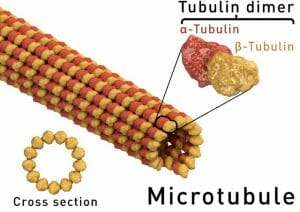Microtubule Definition
Microtubules are microscopic hollow tubes made of the proteins alpha and beta tubulin that are part of a cell’s cytoskeleton, a network of protein filaments that extends throughout the cell, gives the cell shape, and keeps its organelles in place. Microtubules are the largest structures in the cytoskeleton at about 24 nanometers thick. They have roles in cell movement, cell division, and transporting materials within cells.
Microtubule Structure
Microtubules are hollow cylinders made up of repeating protein structures, specifically dimers of alpha and beta tubulin (also referred to in writing as ɑ-tubulin and β-tubulin). Dimers are complexes of two proteins. ɑ-tubulin and β-tubulin bind to each other to form a dimer, and then multiple units of these dimers bind together, always alternating alpha and beta, to form a chain called a protofilament. Then, thirteen protofilaments arrange into a cylindrical pattern to form a microtubule. Microtubules are constantly assembling and disassembling via the addition and removal of dimers. They are said to be in a state of dynamic equilibrium because their structure is maintained even though the individual molecules themselves are constantly changing.
Microtubules are polar molecules, with a positively charged end that grows relatively fast and a negatively charged end that grows relatively slow. Protofilaments arrange themselves parallel to each other in a microtubule, so the positive end of the microtubule always has beta subunits exposed, while the negative end has alpha subunits exposed. Having polarity allows the microtubule to assemble in a specific way and function correctly.
In animal cells, microtubules radiate outwards from an organelle in the center of the cell called a centrosome, which is a microtubule organizing center (MTOC). The cells of plants and fungi do not have centrosomes, and instead the nuclear envelope—the membrane surrounding the cell’s nucleus—is an MTOC.

This image shows the structure of a microtubule.
Function of Microtubules
Cell Movement
Microtubules give structures like cilia and flagella their structure. Cilia are small protuberances of a cell. In humans, they are found on cells lining the trachea, where they prevent materials like mucus and dirt from entering the lungs. They are also found in the fallopian tubes of the female reproductive system, where they help move the egg that is released from the ovary to the uterus. Flagella are tail-like appendages that allow cells to move. They are found in some bacteria, and human sperm also move via flagella. Microtubules also allow whole cells to “crawl” or migrate from one place to another by contracting at one end of the cell and expanding at another.
Cell Division
Microtubules play a key role in forming the mitotic spindle, also called the spindle apparatus. This is a structure that is formed during mitosis (cell division) in eukaryotic cells. The mitotic spindle organizes and separates chromosomes during cell division so that the chromosomes can be partitioned into two separate daughter cells. Its components include microtubules, the MTOC, and microtubule-associated proteins (MAPs).
Three subgroups of microtubules aid in the process of mitosis: astral, polar, and kinetochore microtubules. Astral microtubules radiate from the MTOCs of a cell to the cell membrane, keeping the mitotic spindle in place. Polar microtubules intertwine between two MTOCs and help separate chromosomes. (All microtubules are polar; these ones are just specifically called polar microtubules.) Kinetochore microtubules attach to chromosomes to help pull them apart; the chromosomes are attached to the microtubules by a complex of proteins called a kinetochore.
Cell Transport
As part of the cytoskeleton, microtubules help move organelles inside a cell’s cytoplasm, which is all of the cell’s contents except for its nucleus. They also help various areas of the cell communicate with each other. However, even though microtubules help components of the cell to move, they also provide the cell with shape and structure.
Other Cytoskeletal Components
The other two main components of the eukaryotic cytoskeleton are microfilaments and intermediate filaments. Microfilaments are smaller than microtubules at about 7 nm in diameter. They aid in the division of cytoplasm during cell division, and also have a role in cytoplasmic streaming, which is the flow of cytosol (cell fluid) throughout the cell. Intermediate filaments are bigger than microfilaments, but smaller than microtubules. They help give the cell its shape and provide structural support.
Related Biology Terms
- Tubulin – The protein that makes up microtubules.
- Cytoplasm – All the contents of a cell except for the nucleus.
- Spindle apparatus – A structure formed mainly by microtubules that separates chromosomes during mitosis.
- Kinetochore – A protein complex that helps attach chromosomes to microtubules in the mitotic spindle.
Quiz
1. Centrosomes are found in which type of cell?
A. Fungal
B. Animal
C. Plant
D. Bacterial
2. Microtubules are the ______ components of the cytoskeleton.
A. Thickest
B. Thinnest
C. Longest
D. Shortest
3. Which is NOT a function of microtubules?
A. To help chromosomes separate during cell division
B. To form cilia and flagella
C. To help the cell move from one place to another
D. To aid in the division of cytoplasm during mitosis
Microtubule
No comments:
Post a Comment